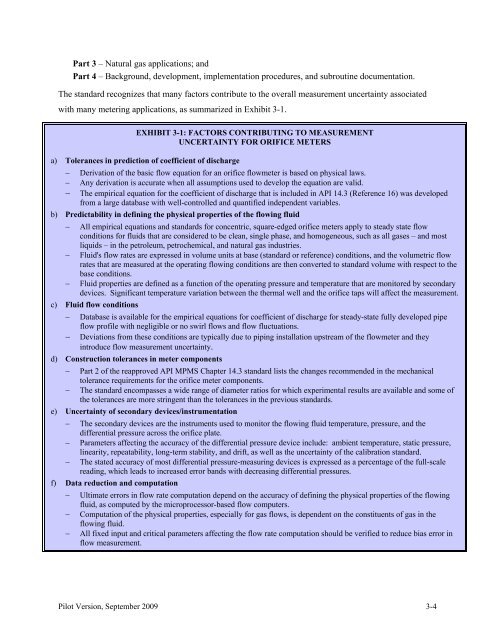addressing uncertainty in oil and natural gas industry greenhouse
addressing uncertainty in oil and natural gas industry greenhouse
addressing uncertainty in oil and natural gas industry greenhouse
You also want an ePaper? Increase the reach of your titles
YUMPU automatically turns print PDFs into web optimized ePapers that Google loves.
Part 3 – Natural <strong>gas</strong> applications; <strong>and</strong><br />
Part 4 – Background, development, implementation procedures, <strong>and</strong> subrout<strong>in</strong>e documentation.<br />
The st<strong>and</strong>ard recognizes that many factors contribute to the overall measurement <strong>uncerta<strong>in</strong>ty</strong> associated<br />
with many meter<strong>in</strong>g applications, as summarized <strong>in</strong> Exhibit 3-1.<br />
EXHIBIT 3-1: FACTORS CONTRIBUTING TO MEASUREMENT<br />
UNCERTAINTY FOR ORIFICE METERS<br />
a) Tolerances <strong>in</strong> prediction of coefficient of discharge<br />
− Derivation of the basic flow equation for an orifice flowmeter is based on physical laws.<br />
− Any derivation is accurate when all assumptions used to develop the equation are valid.<br />
− The empirical equation for the coefficient of discharge that is <strong>in</strong>cluded <strong>in</strong> API 14.3 (Reference 16) was developed<br />
from a large database with well-controlled <strong>and</strong> quantified <strong>in</strong>dependent variables.<br />
b) Predictability <strong>in</strong> def<strong>in</strong><strong>in</strong>g the physical properties of the flow<strong>in</strong>g fluid<br />
− All empirical equations <strong>and</strong> st<strong>and</strong>ards for concentric, square-edged orifice meters apply to steady state flow<br />
conditions for fluids that are considered to be clean, s<strong>in</strong>gle phase, <strong>and</strong> homogeneous, such as all <strong>gas</strong>es – <strong>and</strong> most<br />
liquids – <strong>in</strong> the petroleum, petrochemical, <strong>and</strong> <strong>natural</strong> <strong>gas</strong> <strong>in</strong>dustries.<br />
− Fluid's flow rates are expressed <strong>in</strong> volume units at base (st<strong>and</strong>ard or reference) conditions, <strong>and</strong> the volumetric flow<br />
rates that are measured at the operat<strong>in</strong>g flow<strong>in</strong>g conditions are then converted to st<strong>and</strong>ard volume with respect to the<br />
base conditions.<br />
− Fluid properties are def<strong>in</strong>ed as a function of the operat<strong>in</strong>g pressure <strong>and</strong> temperature that are monitored by secondary<br />
devices. Significant temperature variation between the thermal well <strong>and</strong> the orifice taps will affect the measurement.<br />
c) Fluid flow conditions<br />
− Database is available for the empirical equations for coefficient of discharge for steady-state fully developed pipe<br />
flow profile with negligible or no swirl flows <strong>and</strong> flow fluctuations.<br />
− Deviations from these conditions are typically due to pip<strong>in</strong>g <strong>in</strong>stallation upstream of the flowmeter <strong>and</strong> they<br />
<strong>in</strong>troduce flow measurement <strong>uncerta<strong>in</strong>ty</strong>.<br />
d) Construction tolerances <strong>in</strong> meter components<br />
− Part 2 of the reapproved API MPMS Chapter 14.3 st<strong>and</strong>ard lists the changes recommended <strong>in</strong> the mechanical<br />
tolerance requirements for the orifice meter components.<br />
− The st<strong>and</strong>ard encompasses a wide range of diameter ratios for which experimental results are available <strong>and</strong> some of<br />
the tolerances are more str<strong>in</strong>gent than the tolerances <strong>in</strong> the previous st<strong>and</strong>ards.<br />
e) Uncerta<strong>in</strong>ty of secondary devices/<strong>in</strong>strumentation<br />
− The secondary devices are the <strong>in</strong>struments used to monitor the flow<strong>in</strong>g fluid temperature, pressure, <strong>and</strong> the<br />
differential pressure across the orifice plate.<br />
− Parameters affect<strong>in</strong>g the accuracy of the differential pressure device <strong>in</strong>clude: ambient temperature, static pressure,<br />
l<strong>in</strong>earity, repeatability, long-term stability, <strong>and</strong> drift, as well as the <strong>uncerta<strong>in</strong>ty</strong> of the calibration st<strong>and</strong>ard.<br />
− The stated accuracy of most differential pressure-measur<strong>in</strong>g devices is expressed as a percentage of the full-scale<br />
read<strong>in</strong>g, which leads to <strong>in</strong>creased error b<strong>and</strong>s with decreas<strong>in</strong>g differential pressures.<br />
f) Data reduction <strong>and</strong> computation<br />
− Ultimate errors <strong>in</strong> flow rate computation depend on the accuracy of def<strong>in</strong><strong>in</strong>g the physical properties of the flow<strong>in</strong>g<br />
fluid, as computed by the microprocessor-based flow computers.<br />
− Computation of the physical properties, especially for <strong>gas</strong> flows, is dependent on the constituents of <strong>gas</strong> <strong>in</strong> the<br />
flow<strong>in</strong>g fluid.<br />
− All fixed <strong>in</strong>put <strong>and</strong> critical parameters affect<strong>in</strong>g the flow rate computation should be verified to reduce bias error <strong>in</strong><br />
flow measurement.<br />
Pilot Version, September 2009 3-4

















